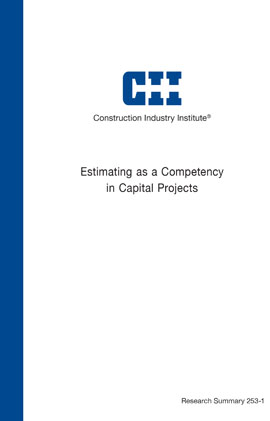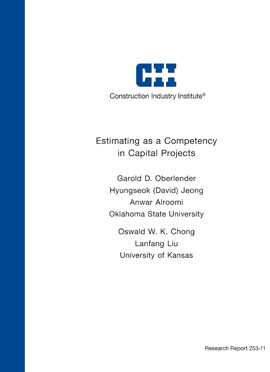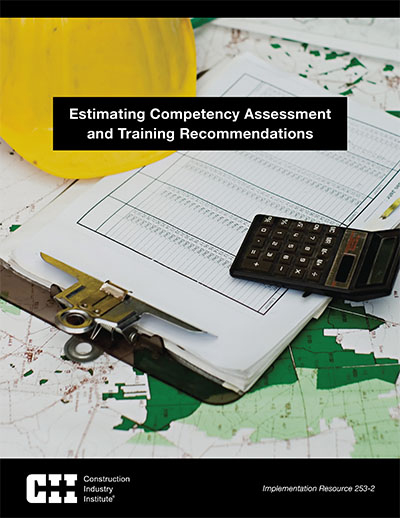
Estimating as a Competency in Capital Projects
Cost estimating is a critical function for successful capital projects, and reliable estimates depend heavily on the competency of cost estimators. Tools that aid the estimating process cannot replace the judgment and experience of a competent estimator. The greatest challenge facing the cost estimating community over the next decade will be the loss of the knowledge and experience of the highly experienced estimators who will be retiring. A large percentage of experienced estimators are now either retiring or planning retirement, and there is an acute shortage of qualified cost estimators to replace them in the engineering and construction industry.
CII Research Team (RT) 253 was chartered to find solutions to both issues: the short supply of competent estimators and the loss of knowledge and experience of retiring estimators. RT 253 confirmed that there is indeed a serious shortage of cost estimators, now and for the immediate future, and that there are growing concerns about the gaps in the estimating competencies of junior estimators. For this study, the research team conducted four independent surveys and collected extensive data to accomplish the following objectives
- Identify cost estimating competencies and investigate the gaps between the current and desired level of cost estimating competencies.
- Identify effective methods to recruit, attract, and retain cost estimators.
- Identify effective methods and strategies to transfer estimating knowledge and skills.
- Develop plans to educate and train new estimators.
- Identify career paths for cost estimators.
The team also identified effective solutions to fill these gaps. The solutions identified in this study include the following:
- more effective and targeted recruitment methods
- more effective methods to attract and retain cost estimators
- efficient methods to transfer estimating knowledge and skills
- development of ideal career paths.
The team produced the following deliverables:
- Research Summary 253-1, Estimating as a Competency in Capital Projects
- Implementation Resource 253-2, Estimating Competency Assessment and Training Recommendations
- Research Report 253-11, Estimating as a Competency in Capital Projects.
The findings in this study can be used as a set of practical guides when designing and developing recruitment and retention plans for cost estimators, cost estimating training programs, and a long-term career development plan for cost estimators in the engineering and construction industry.
The greatest challenge facing the estimating community over the next several years is the loss of knowledge and experience from highly experienced estimators. A large percentage of experienced estimators are retiring and there is a shortage of qualified cost estimators to replace them. The report focuses on these 6 objectives to help solve this challenge. (RS253-1, p. v)
- Identifying cost estimating competencies
- Investigating the gaps between the current and desired level of cost estimating competencies
- Identifying effective methods to recruit, attract, and retain cost estimators
- Identifying effective methods and strategies to transfer estimating knowledge and skills
- Developing plans to educate and train new estimators
- Identifying career paths for estimators
The competencies of cost estimators can be defined as the cluster of interrelated skills, knowledge, and personal attributes required to perform an estimating job. In this research, a total of 23 were identified as required competencies of cost estimators divided into three categories: skills, knowledge, and personal attributes. Furthermore, these have been subdivided into “Hard” and “Soft” components. Soft skills are difficult to teach or develop. These are generally experienced based. Hard skills are relatively easy to teach and learn. These can be obtained in traditional classroom settings and industry training courses on estimating, project scheduling, and software programs. Interestingly, the vast majority of the competencies have been identified as “Soft.” This clearly shows that it takes years of experience to master the art of estimating. These 23 competencies are presented as a "Classification Hierarchy of Estimating Competencies" in the research. (RS253-1, p. 11)
Companies should incorporate more effective methods for attracting and retaining cost estimators. Analysis of the survey data in this research shows that the most effective methods for attracting and retaining estimators are the following: (RS253-1, p. 34)
- Compensation and benefits
- Emphasis on diversity of work in estimating
- More recognition of estimating as a profession
This research developed a tool to help organizations assess each estimator’s competencies and isolate the most critical gaps in his or her skills and knowledge. This data can be used to design cost-effective customized training programs to close the gaps. More details on how to use the tool are shown below under Implementation Tools. (RS253-1, p. 27)



